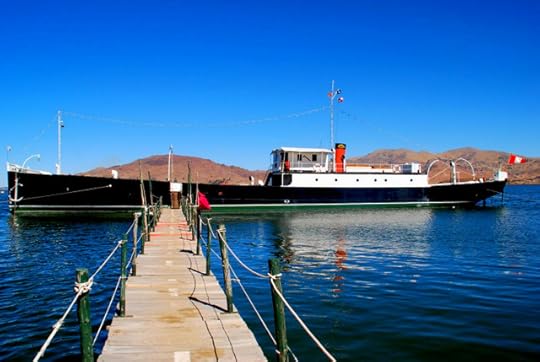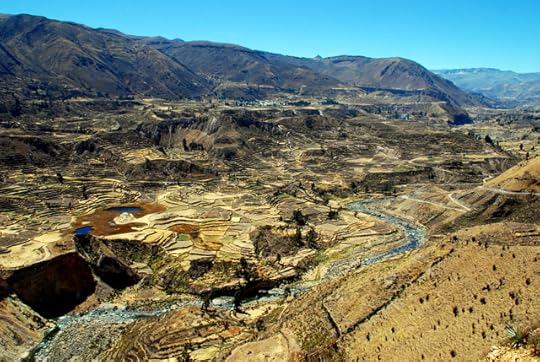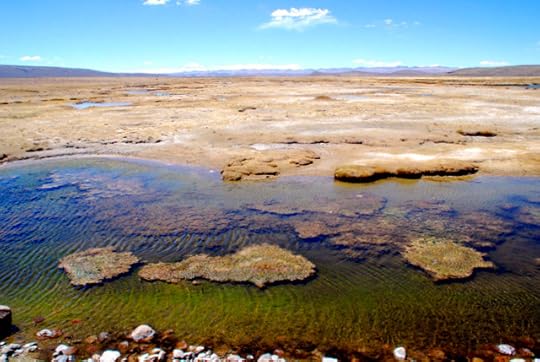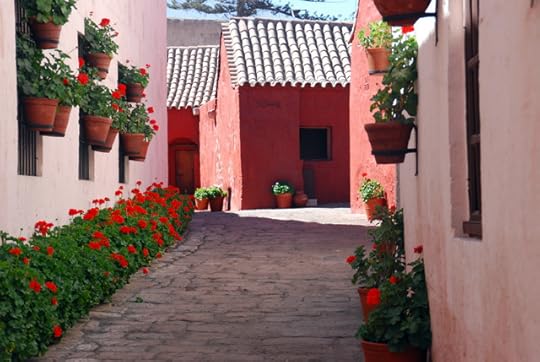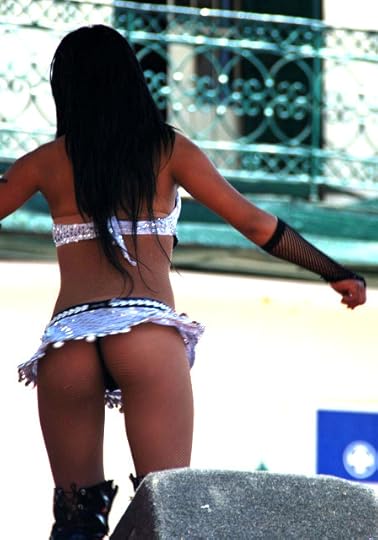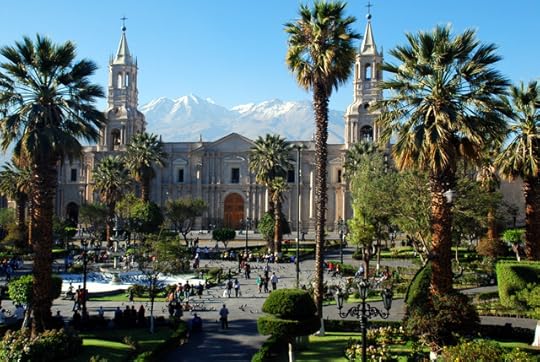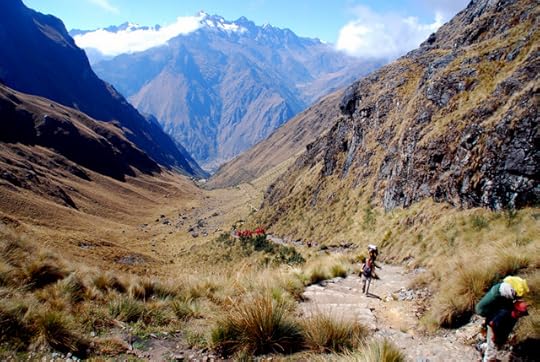Roderick Phillips's Blog, page 33
September 6, 2013
Arequipa to Puno, Day 40
Another early start, although our Cruz del Sur bus is, horror of horrors, late leaving Arequipa. We largely retrace our steps of yesterday across the beautiful golden brown altiplano (beautiful that is aside from all the damned litter – come on guys, clean it up!). We’ve come to expect good food and good movies aboard Cruz del Sur buses (even in second class) and we aren’t disappointed, but the toilet situation is grim. This isn’t the fault of the bus company, however. Signs clearly state toilets are for urination only. Well, today we find out what happens when the rules are broken. A truly foul odor emanates from the bathroom every time the toilet is flushed – and this is a 6-hour bus ride. Christi almost gags!
Puno is enjoying a holiday today and the center of town is dead, so we walk down to the waterfront which is located on the shores of Lake Titicaca, another iconic destination in South America. We see the local Aymara people in rowing boats (a step up from the more traditional totora reed boats), and colorful paddle boats with which to explore the harbor. The 150-year-old MV Yavari is also docked permanently in Puno harbor. It was commissioned from a British shipyard by the Peruvian navy in 1861 to patrol the lake. The boat was shipped in pieces from Britain to South America and then carried over the Andes by mule train. It was not until 1870 that the boat was finally assembled and launched. Initially, it used llama dung as a fuel source but required so much of the stuff that it could never go far without stopping to refuel. At least there was plenty of llama dung available! Not surprisingly, the MV Yavari was eventually converted to oil.
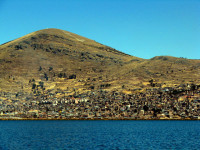
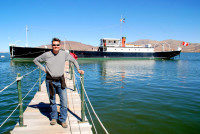
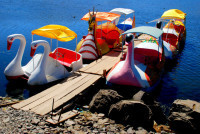
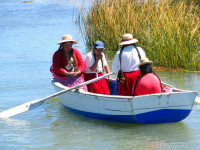
Possibly the only restaurant open tonight is a rather tasty Peruvian pizzeria, and we take our first anti-malarial pills with dinner. Lariam is not for the faint-hearted, the potentially psychotic, or those with liver disorders. My first experience with once-weekly Lariam was in 1997. The night I took the drug I was guaranteed the most disturbing and vivid dreams that typically ended with me being murdered in a pool of crimson blood. Later, I met a guy in Borneo who swore Lariam gave him the most erotic dreams of his life. Lucky bastard.
The post Arequipa to Puno, Day 40 appeared first on Roderick Phillips.
September 5, 2013
Colca Canyon, Day 39
I forgot to mention yesterday that Colca Canyon (where colca translates as store room or granary) is South America’s equivalent of the Grand Canyon (and the Fish River Canyon in Namibia – rather obvious name-dropping there). Colca Canyon is, depending on who you speak to, either the deepest canyon in the world or the second deepest. Cotahuasi appears to compete with Colca Canyon for bragging rights. One fact not in doubt, however, is that Colca Canyon is twice as deep as the Grand Canyon – so it’s a big hole in the ground by anyone’s definition.
But much like a day trip to the Grand Canyon, we could only scratch the surface of Colca Canyon. And rather than see where ‘X’ marks the deepest spot, we explore the shallower end of the canyon which is home to several villages and some breath-taking agricultural terracing. Further along the canyon at Cruz del Condor we are privileged to view one of Nature’s beautiful, yet sadly fast disappearing, spectacles: the flight of the Andean condor. Our guide says that only about 100 of these impressive birds remain in Peru and continuing climate change could ultimately lead to their extinction. We gaze into the canyon hoping to spot these giants birds and there down in the bowels of the earth we glimpse several tiny specks, no bigger than a butterfly. Over the next hour, however, the condors fly higher and higher on the back of warm air currents, eventually soaring out of the canyon and zooming fast and low over our heads. An absolutely spectacular experience.
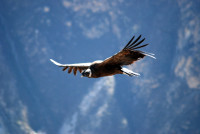
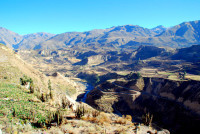
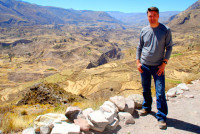
A long drive back to Arequipa follows. I just manage to retrieve my newly repaired hiking boots from the zapatero before the shop closes and then we return to the Home Sweet Home hostel and pack our bags. Tomorrow we move on again.
The post Colca Canyon, Day 39 appeared first on Roderick Phillips.
September 4, 2013
Peruvian altiplano, Day 38
We leave Arequipa on our Colca Canyon tour at 9 am. Our route takes us up onto the barren Peruvian alitiplano (an area of high plateau and vast plains lying between 11,000 and 13,000 feet) which, litter aside, is starkly beautiful. The grass is golden brown with stunted bushes and rolling hills that culminate in the massive snow-capped mountains of Ampato (of Juanita, the Ice Princess, fame) and Sabancaya.
Along the way, we stop briefly at Reserva Nacciojnal Salinas y Aguada blanca, home to the endangered vicuñas, which are wild cousins to the domesticated llamas and alpacas (and all are members of the camelid family and are therefore related to camels).
The animals are not hard to spot, but we’re not allowed to get too close. Vicuñas give the softest wool (and hence the most expensive shawls, scarves, sweaters etc.). The high point on the drive is 4,800m (15,750 feet), which is also the highest we’ve been in the Andes so far. Before we leave the park we also spot a viscacha (a rabbit-like rodent) hiding among some boulders.
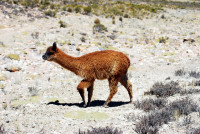

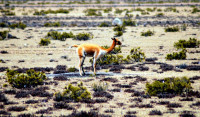
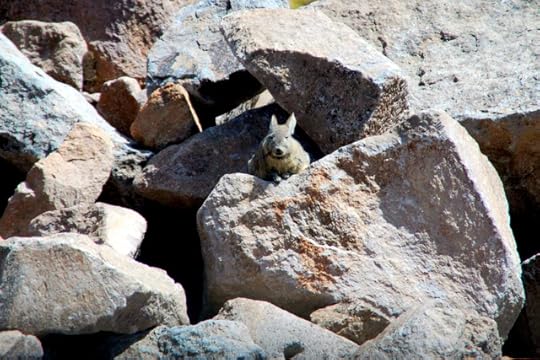
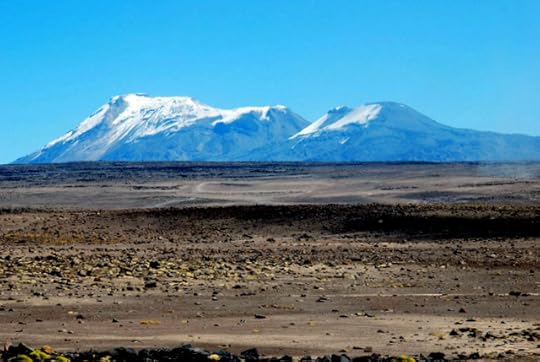
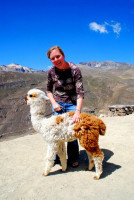
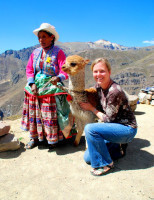
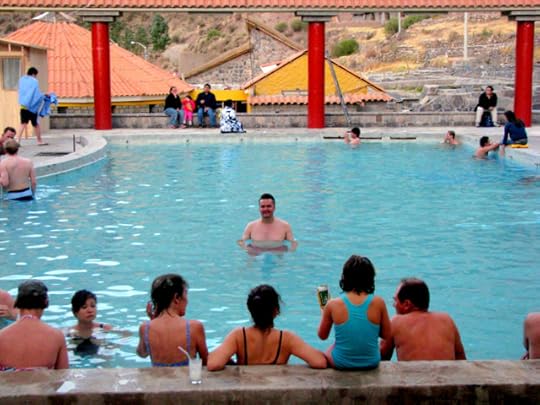
Our destination for the day is Chivay, located high in the Peruvian altiplano (12,000 feet). The town resembles a dusty, deserted Mexican settlement that Clint Eastwood or The Magnificent Seven might ride into to save the inhabitants from blood-thirsty bandits. The reason the town is deserted, by the way, is that everyone is relaxing in the nearby hot springs. Christi and I join the locals for a soothing dip. But the fun does not stop there. In the evening, our guide ‘encourages’ us to join him for dinner and traditional folk dancing. It’s the typical banal tourist fare, until I’m dragged onto the dance floor, and for reasons that are not clear to me, the (admittedly adorable) indigenous lady starts whipping me and forcing me down on the ground. Before I can recover, she is sitting on my face and rotating her butt quite contentedly. Perhaps this is the local version of a lap dance. Christi finds the whole thing hysterical. Fortunately, there are no photos of me getting whipped (at least not by the Quechuan lady).
The post Peruvian altiplano, Day 38 appeared first on Roderick Phillips.
September 3, 2013
Santa Catalina monastery, Arequipa, Day 37
Today we enjoy the tourist delights of Arequipa. First is the vast Santa Catalina monastery (actually a convent), which covers a whole city block. It was founded in 1580 and mainly attracted girls from the richest families in Spain (admittance to the convent required considerable dowries). But not all the girls went willingly. Not surprisingly, they were loath to give up their opulent lifestyle for the cloistered life of a nun in Peru (cloistered meaning a simple life cut off from the outside world). Rumor has it, though, that these wealthy Spanish girls bent the rules quite alarmingly, paying to have servants and the less well-off nuns do their chores and purchasing luxury items from the town, including, allegedly, men.
By 1970, however, the convent was falling into disrepair and – unable to support itself – the Catholic church reluctantly embraced a version of glasnost, allowing you and I (for a fee) to poke around the old place. The convent is full of brightly colored plazas, cobblestone alleys, art galleries, places of worship, and period rooms where the nuns lived (and occasionally worked). We eat lunch at the convent cafe, which offers such solemn dishes as the Truth baked potato and the Salad of Diligence. I’m not sure that was enough for me to experience a religious epiphany, but my stomach was certainly very happy for the rest of the day.

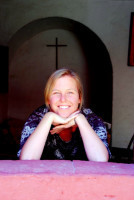

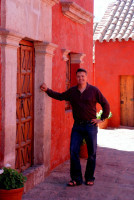
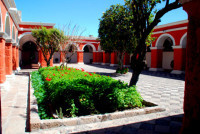 [image error]
[image error]
Another fantastic attraction in Arequipa is Juanita, the Ice Maiden. She was an Inca Princess who from the time of her birth was scheduled for sacrifice. It’s believed that a huge ceremony was held in the Inca capital of Cusco and the poor girl (and her entourage) were sent to a trouble spot in the empire. In this case Juanita was told to climb the symbolic Mt. Ampato (6,300m / 20,700 feet), near Arequipa. She is known (from an analysis of her stomach contents) to have consumed a large amount of alcohol at the time of her sacrifice so with luck she did not feel the fatal blow to her head (struck by one of her entourage). And there she remained, perfectly preserved in ice for the next 500 years, until nearby Mt. Sabancaya erupted in the mid-1990s melting the snow and ice on Ampato, and exposing her body. Now she sits in her own climate-controlled mausoleum in Arequipa for all the world to see. Her funerary accoutrements were equally well preserved, including an immaculate embroidered blue woolen shawl that could have been made today.
Arequipa is just a darned cool place to spend a few days.
The post Santa Catalina monastery, Arequipa, Day 37 appeared first on Roderick Phillips.
September 2, 2013
Spanish language woes, Arequipa, Day 36
Yesterday was as close as it gets to a relaxing day for us, but before we embark upon another adventure we have some chores to complete. My hiking boots suffered more than I did on the Inca trail and we have to find a cobbler to get them repaired. And do you think Christi and I know the Spanish word for cobbler? Of course not (Note, it’s zapatero) so the only way to find one is to keep showing my distraught boot to the locals. By the way, the cobbler’s shop is well off the tourist trail.
Incidentally, while there is a rare lull in the action I thought I’d mention a few other Spanish words that amuse me. The first is ferreteria. Now lavenderia is a place to go to do your laundry (i.e., a laundrette) which makes sense, but ferreteria is not a place to go to buy ferrets (a small mammal belonging to the weasel family). The thought of a whole shop devoted to selling ferrets just cracks me up. Perhaps it’s an English thing – I think we must have a soft spot for ferrets. There was even a TV show called Last of the Summer Wine where one of the characters was famous for keeping a ferret down his trousers. The sexual inuendos were endless. By the way ferreteria is a hardware store. The second word is embarazada. Doesn’t that sound like embarrassed? It actually means pregnant! Embarrassed is avergonzado. Of course it’s possible that you might be avergonzado if you are embarazada! And you don’t want to be shouting out ‘estoy excitada’ thinking you are saying I’m excited about something. The closest translation is I’m aroused or I’m horny. So now you know.
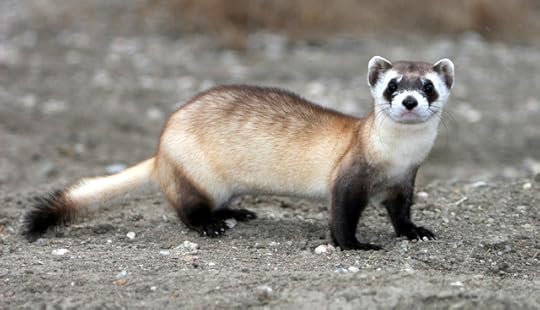
ferret but not ferreteria (image courtesy of savenaturesavehuman.blogspot.com)
Once I’d handed in my boots to be repaired, the rest of the day is split between an internet café and the Zig Zag creperie. At the creperie we find a secluded nook and while Christi reads, I edit photos from Cusco and the Inca trail on our portable DVD player. We drink copious amounts of hot chocolate (me) and coffee (Christi) and enjoy savory crepes for lunch and ice cream crepes for dessert. Back at the internet café, Christi uploads hundreds more photos to Picasa, while I read and plan the next stages of our trip. Both of these activities take a long time and we don’t make it back to the hostel until 9 pm. We veg in front of the TV watching CSI (mostly because it’s the only English language show we can find) eating something akin to a TV dinner: peanut butter and crackers (Christi) and chicken empanada, Twix and coke (me). As you can see, we’re really living it up in Arequipa. Estoy excitada – no, really!
The post Spanish language woes, Arequipa, Day 36 appeared first on Roderick Phillips.
September 1, 2013
Cusco to Arequipa Day 35
It’s only 200km from Cusco to Arequipa, but it’s a tortuous route through the mountains and it’s still raining. The journey takes 10 uncomfortable hours. And boy is there a big difference between traveling first class and second. At some god-forsaken hour during the middle of the night, I wander downstairs and sneak an envious peak into the luxurious first class cabin, but I’m quickly ushered back into second class hell. It’s a long, cold night and I sleep very little. Note to self: on long overnight bus rides, suck it up and pay a little extra for first class.
We arrive in Arequipa at 6.30am and taxi to the Home Sweet Home hostel. Hostels typically offer dorm accommodation, but the majority also have a few matrimonial rooms available, which really don’t cost that much more than two dorm beds. Once again, we’re shown straight to our rooms and after a revitalizing shower we’re snoring peacefully by 8am.
We struggle awake at noon and begin to explore. As with most every place we visit, we’re staying in the tourist section of town, well away from the real lives of the locals. Arequipa is yet another pretty colonial city, set against the back drop of numerous volcanoes (all of which are part of the Pacific Ring of Fire). Arequipa is known as the White City because many of its most important buildings are made of white volcanic stone. We migrate quite naturally to yet another Plaza de Armas. We enjoy a long, late, lazy lunch on a second floor balcony overlooking the large, central plaza, which is great for people watching. Christi enjoys her first glass of red wine since those far off days aboard the MV Samba when we were cruising around the Galapagos Islands.


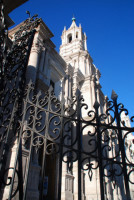
The post Cusco to Arequipa Day 35 appeared first on Roderick Phillips.
August 31, 2013
Aguas Calientes to Cusco Day 34
Aguas Calientes is nestled in a valley below Machu Picchu, surrounded by towering walls of rock and the cloud forest. It’s located on the Urubamba river, while train tracks run through the center of town. This is undoubtedly a huge tourist town, but after so much nature lately, I don’t mind being showered in cuddly llamas and alpaca blankets – at least for an hour or two.
Our return to Cusco is partly by train (to Ollantaytambo) and then by Llamapath minibus. But there’s already a problem. PeruRail have canceled our 2pm train and we’re told we have to pay extra for a seat on the 4pm service. Our broken Spanish is insufficient to truly understand the situation or to communicate our concerns (that Llamapath will not wait for us at Ollantaytambo and that we’ll miss our evening bus connection from Cusco to Arequipa). Initially, the harassed staff at PeruRail wave away our concerns, but then something wonderful happens. Something that often happens, I’ve found, to a stranded traveler. Human kindness takes over, and Christi and I are suddenly ushered onto the 2.20pm service (where did that come from?) and life is good again.
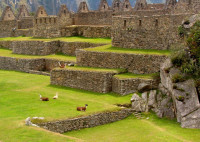
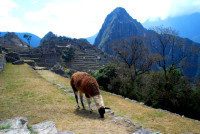

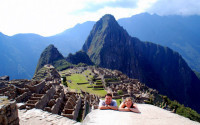
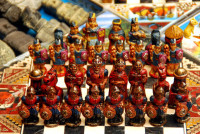
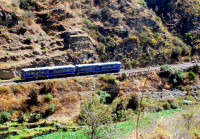
We’re dropped outside the Llampath office during a monster thunderstorm. We collect our packs, say goodbye to the staff, and wolf down a dinner of Peruvian fried chicken and fries at a nearby restaurant before taxiing to the Cruz del Sur bus station. Collapse into our second class seats on the upper level of this double-decker bus in time for a prompt (8.30pm) departure, our somewhat disheveled faces caught forever on the company’s security video.
The post Aguas Calientes to Cusco Day 34 appeared first on Roderick Phillips.
August 30, 2013
Machu Picchu, Day 33
The big day is finally here and I feel we have earned the right to view the majesty of Machu Picchu, Hiram Bingham’s Lost City of the Incas. Christi and I are woken at 3:30am. It’s raining and we’re sleep deprived, but the adrenaline is kicking in. We eat our final, mammoth breakfast (thank you, porters) and move quickly out of camp for the 60-minute hike to the Sun Gate (Intipunku). Of course, all the hikers are scrambling to reach the Sun Gate before dawn to see the first rays of the sun strike the Lost City, so it’s a fairly chaotic scene.
Sadly fog and drizzle obscures the view, which shouldn’t be a surprise really considering Machu Picchu is located in a cloud forest. Flavio assures us the views will improve as the fog burns off, so we trudge on. Perhaps most disappointing of all, though, is the sight of camera flashes in the ruins below us. The day-trippers from the nearby town of Aguas Calientes have already been allowed in and are enjoying the ruins in solitude. I thought it was the survivors of the Inca trail who had that privilege. Apparently not.
The classic Machu Picchu view is from the Guardhouse, which is rapidly inundated with hikers and tourists, while whistle-happy park rangers try in vain to maintain order. Flavio tries to make himself heard above the dozens of other tour guides as he narrates the Machu Picchu story. We stumble between agricultural terraces, the sun temple, the three windows temple, the Intihuatana stone and the Royal enclosures, and then, suddenly, it’s all over. Good afternoon, good evening, and good night.
Most of our hiking group is heading back to Cusco today and have to leave now. Christi and I are staying in Aguas Calientes tonight, so we can explore Machu Picchu at our leisure. By mid-afternoon, most of the tour groups and the hikers have left and we finally have a chance to enjoy the ruins in relative peace and solitude – the odd grazing llama aside. Now this is why I hiked the Inca trail.
We reluctantly board the last bus to Aguas Calientes, and in one final touch of Inca irony, our hotel is located at the top of a steep hill. The hot shower and cozy bed are divine.
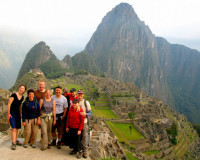
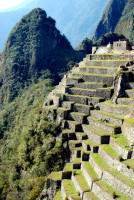
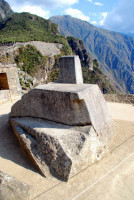
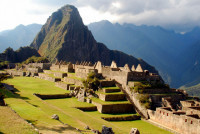
The post Machu Picchu, Day 33 appeared first on Roderick Phillips.
August 29, 2013
Mt. Pumaciello, Inca trail, Day 32
The sunrise over Mt. Pumaciello this morning is sublime…
The night was milder that I’d anticipated, although I did wear every item of clothing I brought with me, so that may have helped. The view from our tent this morning of the sun striking the glaciers of Mt. Pumaciello is simply sublime. I bounce out of bed to capture the moment for posterity.
Flavio says today will be easier – only 10 km – but he is an incorrigible optimist. The elevation gain to the top of the third and final pass we shall cross (Phuyupatamarka at 3680m / 12,000 feet) is only 80m and then it’s downhill all the way to Machu Picchu (at 2,400m / 7874 feet), baby. But we’re getting ahead of ourselves; the Lost City of the Incas is still 15 km away and we won’t reach it until early tomorrow morning. Between us and our goal are the spectacular Inca ruins of Phuyupatamarka, the terraces of Intipata, a beautiful cloud forest and a trail of endless stone steps, irregularly spaced and irregularly shaped. Quite how no one sprains an ankle or breaks a leg is beyond me. Still the cloud forest with its sphagnum moss, Spanish moss, lichens and epiphytes (bromeliads, ferns and orchids) conjures up fantastic images of an ancient, Jurassic park-like world. Who knows what’s watching us from the dense undergrowth or what lies around the next corner?
Well it ain’t T-Rex. It’s not even a dinosaur fossil. But it is another Inca ruin. And nothing makes Flavio happier than relating some fascinating tidbit of information about one of these ancient sites. My mind, which is so full of fluff anyway, can’t digest another Inca fact and I resort to looking for teeny tiny monsters in the undergrowth, instead. Our last stop of the day is at the partially rebuilt site of Winaywayna, which is beautifully located on a precipitous mountain slope. It’s so much easier to appreciate the Inca civilization when the ruins have some meat on the bones. I love it.
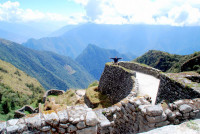
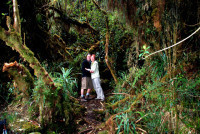
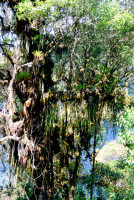
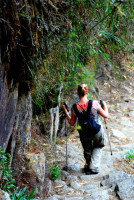

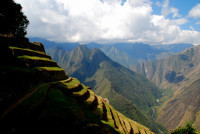
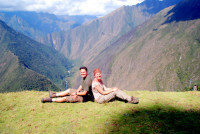
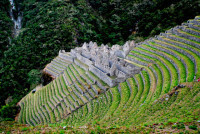
I don’t love the nearby campsite (also called Winaywayna), however. It seems as if every hiker on the trail is staying here tonight, waiting for the mad dash to Machu Picchu early tomorrow morning. And the repeated mad dashes to the ablution block throughout the evening means the toilets become rapidly…overwhelmed.
The post Mt. Pumaciello, Inca trail, Day 32 appeared first on Roderick Phillips.
August 28, 2013
Dead Woman’s Pass, Inca trail, Day 31
The hike to Dead Woman’s Pass is Death by Stairmaster…
I endure a cold and uncomfortable night under canvass. And not once did those damn porters come by with a hot water bottle. I say night, but the porters woke Christi and me at 5.30am, admittedly with hot tea and hot water for washing. Breakfast is waiting for us, and while we eat, our tents miraculously disappear into the porter’s packs. Honestly the luxury we’re experiencing at the expense of these guys is embarrassing.
Flavio, our guide, reminds us that we have two passes to climb today. The first is Dead Women’s Pass (DWP) at 4,200m (13,799 feet) which is followed by a steep descent and then another ascent to Runkuraqay pass at 4,000m (13,123 feet). And while it’s only 3 km from our campsite to the top of DWP, there’s a 900m elevation gain – so it’s steep; real steep. I hike slow and steady, but my rhythm is continuously interrupted by the irregularly cut Inca steps, which are tough on the knees. I stagger to the top after 2.5 hours of lung-busting, heart-pumping hiking and while the tourists all stop to celebrate this major mountaineering achievement, the porters continue on to our lunch stop, barely pausing for breath. Christi and I enjoy the spectacular views, until a cool, goose-bump inducing mist envelops us. It reminds me of the movie, The Fog, but fortunately, nothing supernatural materializes and we start the downhill section, losing 600m in elevation over the next 5 km. Each downward step causes my joints to shudder.
Lunch is a blessing and a curse. I’m starving, of course, but once I stop hiking, my irascible muscles seize up and only very reluctantly do they start working again. By this point, my body is drawing energy away from my limbs to digest the fried chicken, quinoa, vegetables, and soup I ate at lunch, while I’m forcing those same energy-starved limbs to get me to the top of the second pass. After 90 minutes of seriously strenuous exertion, I’m there.
Flavio breaks up the afternoon trek with stops at various Inca ruins. My favorite is the guard post, Qoncharmarca, nestled deep in the cloud forest. Christi and I are relieved to finally reach our camp site, Chaquicocha (3,600m), at 5.30pm after 16 grueling kms. I gorge myself at dinner and I’m fast asleep by 8.30pm, sure in the knowledge that the most arduous part of the hike is behind me.

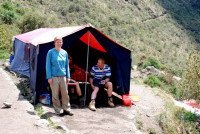
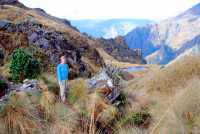
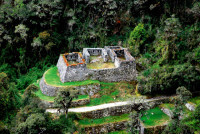
The post Dead Woman’s Pass, Inca trail, Day 31 appeared first on Roderick Phillips.

